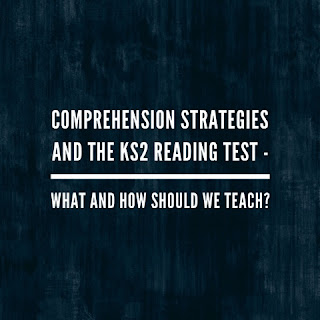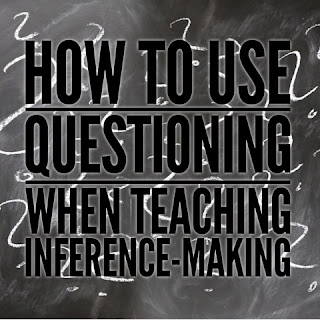Is there a way to teach comprehension strategies that prepares children well for the KS2 reading test?
 In answering my second question I had to consider that which is different about the reading test. Whereas the commonly-used comprehension strategies do not require children to give written answers to questions they ask or generate themselves, the test does. This is the main difference. In addition to this, the year 5/6 National Curriculum objectives mention no requirement for children to provide written answers to questions and many of the objectives aren't tested at all by the SATs. The objectives circled in red aren't tested by SATs; the ones outlined in blue are.
In answering my second question I had to consider that which is different about the reading test. Whereas the commonly-used comprehension strategies do not require children to give written answers to questions they ask or generate themselves, the test does. This is the main difference. In addition to this, the year 5/6 National Curriculum objectives mention no requirement for children to provide written answers to questions and many of the objectives aren't tested at all by the SATs. The objectives circled in red aren't tested by SATs; the ones outlined in blue are.Without having any evidence back this up with, I believe that there are children who, having been taught strategies which have become skills, are able to complete the reading test, confidently giving written answers to the questions it asks. I suspect that these children are also able writers and they have probably had a healthy relationship with literacy in general from an early age. There is a potential argument here for a sole focus on teaching comprehension strategies and never asking children to spend time practising giving written answers to comprehension questions.
 But, I also think that there are probably children for whom some explicit instruction about how to give written answers to comprehension questions will be useful and necessary (if they are to have a chance of demonstrating their reading skills in a test, which all year 6 children are). Again, I have no research evidence to back this up, only anecdotal experience. However, there is research evidence to back up the idea that particular written activities do support reading comprehension.
But, I also think that there are probably children for whom some explicit instruction about how to give written answers to comprehension questions will be useful and necessary (if they are to have a chance of demonstrating their reading skills in a test, which all year 6 children are). Again, I have no research evidence to back this up, only anecdotal experience. However, there is research evidence to back up the idea that particular written activities do support reading comprehension.I turned to Steve Graham and Michael Hebert's 'Writing to Read' report which states:
"Writing-about-text activities had a positive impact on struggling students’ understanding of a text. An important key to success in using these activities with lower-achieving students was to provide them with ongoing practice and explicit instruction."
The report recommends that students do write in response to things they have read and outlines a series of recommendations of activities. One of the recommendations is that teachers should have students answer questions about a text in writing, or create and answer written questions about a text:
"Answering questions about a text can be done verbally, but there is greater benefit from performing such activities in writing. Writing answers to text questions makes them more memorable, as writing an answer provides a second form of rehearsal. This practice should further enhance the quality of students’ responses, as written answers are available for review, reevaluation, and reconstruction (Emig, 1977).
For generating or responding to questions in writing, students either answered questions about a text in writing; received practice doing so; wrote their own questions about text read; or learned how to locate main ideas in a text, generated written questions for them, and then answered them in writing. These practices had a small but consistently positive impact on improving the reading comprehension of students in grade 6–12 when compared to reading or reading instruction."
Lemov et al's 'Reading Reconsidered' also provides plenty of classroom evidence that writing supports reading comprehension. They summarise:
"...the strategic use of writing made reading and discussions of reading- the other core activities of English class—more rigorous, focused, productive and engaging- ‘better’ in short. Writing is a deeply valuable endeavor in its own right, but it is also an endeavor that works in synergy with reading in specific ways."
 |
| From 'Writing To Read' |
What does come through both the 'Writing To Read' report and Lemov et al's 'Reading Reconsidered' chapter entitled 'Writing For Reading' is an emphasis on explicit teaching: if we want children to be able to write well about the things they read in order to develop a better understanding of what they read, we must explicitly teach these skills - they must be modelled well by the teacher.
What I have found is that evidence from both research and successful classroom practice shows that an approach to teaching reading strategies which includes giving children the opportunities to practise giving written answers to comprehension questions (in order to prepare them well for a test) is not something we should avoid, but is something that, if done right, could be beneficial to the children we teach.
 |
| From the IES guide |
If children are only given written comprehension activities the comprehension strategies are not likely to be employed or developed. But if the written comprehension activities are backed up with explicit teaching of the supporting strategies (as well as vocabulary, any other necessary background knowledge and how to write answers), then comprehension strategies should be developed. Such explicit teaching (including modelling and discussion) should focus on ensuring that children know what the strategy is, how it is used and why and when to use it. Children can be shown how to use the strategies when completing written comprehension activities.
The York Reading for Meaning Project assessed three reading comprehension interventions delivered by teaching assistants in 20 primary schools. The three interventions were carried out with children who had been identified as having the poor comprehender profile - the three interventions were intended to help children who struggled with reading comprehension to overcome their problems. The three interventions differed:
- Oral Language Programme: vocabulary, reciprocal teaching with spoken language, figurative language and spoken narrative
- Text Level Programme: metacognitive strategies, reciprocal teaching with written language, inferencing from text and written narrative
- Combined Programme: all of the above (vocabulary, reciprocal teaching with spoken language, figurative language, spoken narrative, metacognitive strategies, reciprocal teaching with written language, inferencing from text and written narrative)
Here then is evidence that children who are struggling with reading comprehension, and are falling behind, will benefit from an oral language programme as intervention. In the context of this blog post - which focuses on teaching all children (including those are aren't struggling with comprehension but are still learning new skills and strategies) - it is worth questioning whether these research findings bear relevance - should we scrap writing as part of first teaching of reading and focus solely on an oral approach?
 | ||
| Examples of combined programmes from The York Reading for Meaning Project: An Overview |
However, the outcomes of the project also show that 'all three interventions (Text Level, Oral Language and Combined) improved children’s reading comprehension skills'. In this blog post I have been suggesting what is essentially a combined programme for everyday classroom-based reading instruction (see the examples above). The question the research doesn't answer is, where first teaching of reading comprehension is concerned (i.e. not interventions for poor comprehenders), whether or not the benefits of writing discussed above are still outweighed by only focusing on an oral-only approach.
What is potentially telling is that 'the children who received the Combined programme experienced all components but at half the quantity of the other two intervention programmes'. What if children were given a whole quantity of both oral and written approaches? Isn't this something that a reading lesson, with an adequate amount of time given over to it, could offer children that an intervention (in this study set at 30 minutes long) could not?
It would be interesting to know which approach (oral, text or combined) shows the best results for all learners rather than interventions for poor comprehenders . For teachers working on helping children to be prepared for KS2 testing it would be good to see research which focuses on first teaching for all learners where the results are taken from SATs performance. Whether you are in support of year 6 testing or not, they are currently a feature of the UK's education system. In order for children to feel prepared (and hopefully not stressed by uncertainty about the tests) and in order for schools to demonstrate accurately the reading ability of their children, most schools will want to allow children to practise giving written answers to comprehension questions. Would it be too much of a gamble in this case for schools to take an oral-only approach?
If you would like Aidan to work with you on developing reading at your school, please visit his website at https://www.aidansevers.com/services and get in touch via the contact details that can be found there.
Expanding on some of the ideas in this blog post, in previous blog posts I have written about...
Expanding on some of the ideas in this blog post, in previous blog posts I have written about...
- how written responses to questions might be used in primary reading lessons: How To Use Questioning When Teaching Inference-Making
- how lessons might focus on one particular reading strategy or skill: Should We Teach Reading Strategies In Isolation Or In Combination?; Reading Comprehension: A Structured Way Of Teaching Inference-Making
- how to write comprehension questions for use in reading lessons: How To Write Good Comprehension Questions
- how reading skills and strategies might work together to build understanding: Scaffolding Structures for Reading Comprehension Skills












